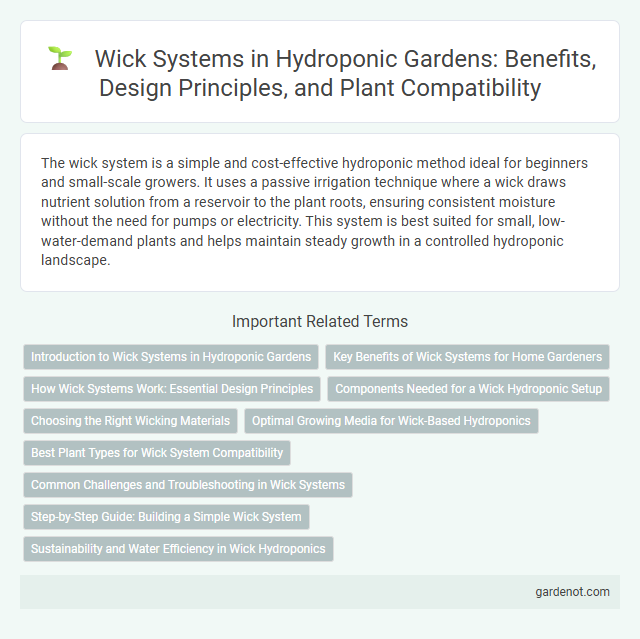The wick system is a simple and cost-effective hydroponic method ideal for beginners and small-scale growers. It uses a passive irrigation technique where a wick draws nutrient solution from a reservoir to the plant roots, ensuring consistent moisture without the need for pumps or electricity. This system is best suited for small, low-water-demand plants and helps maintain steady growth in a controlled hydroponic landscape.
Introduction to Wick Systems in Hydroponic Gardens
Wick systems in hydroponic gardens utilize capillary action to deliver nutrient-rich water from a reservoir to plants through a wick made of absorbent material. This passive hydroponic method requires no pumps or electricity, making it ideal for small-scale or beginner growers. The wick system supports steady moisture levels, promoting healthy root development and efficient nutrient uptake.
Key Benefits of Wick Systems for Home Gardeners
Wick systems offer a low-maintenance hydroponic solution for home gardeners by providing a constant supply of nutrient-rich water directly to plant roots through a simple capillary wick. This passive delivery method eliminates the need for pumps or electricity, making it energy-efficient and cost-effective. Ideal for small-scale gardening, wick systems enhance water conservation and reduce the risk of overwatering while promoting healthy plant growth.
How Wick Systems Work: Essential Design Principles
Wick systems operate by using a passive capillary action where a wick made from absorbent material draws nutrient solution from a reservoir directly to the plant roots. Essential design principles include selecting an appropriately sized wick to ensure consistent moisture delivery without waterlogging, positioning the wick to maintain optimal contact with both the nutrient reservoir and the growing medium, and using a well-aerated medium like coco coir or perlite to facilitate oxygen flow. Properly balancing wick length and thickness is crucial to maintain steady nutrient uptake while preventing root rot and promoting healthy plant growth.
Components Needed for a Wick Hydroponic Setup
A wick hydroponic system requires a growing container, a reservoir filled with nutrient solution, and a wick made from absorbent material such as cotton or nylon to transfer nutrients to the plants. Growing medium like coconut coir, perlite, or vermiculite supports root structure and retains moisture effectively. An air pump is generally unnecessary, making the wick system low-maintenance and ideal for small-scale or beginner hydroponic gardens.
Choosing the Right Wicking Materials
Selecting the right wicking materials significantly impacts the efficiency of hydroponic wick systems by ensuring consistent moisture delivery to plants. Materials such as cotton, nylon, or polyester blends are favored for their absorbency, durability, and capillary action, which directly influence nutrient uptake and root health. Proper material choice prevents waterlogging and promotes optimal aeration, enhancing overall plant growth in hydroponic landscapes.
Optimal Growing Media for Wick-Based Hydroponics
Optimal growing media for wick-based hydroponics include coconut coir, perlite, and vermiculite, which provide excellent water retention and aeration essential for nutrient uptake. These substrates maintain consistent moisture levels, enabling the wick system to deliver nutrients effectively to plant roots without waterlogging. Choosing lightweight, porous media enhances capillary action, improving the efficiency and overall success of hydroponic growth.
Best Plant Types for Wick System Compatibility
Leafy greens such as lettuce, spinach, and kale thrive in a wick system due to their low nutrient and water requirements. Herbs like basil, mint, and parsley also perform well, benefiting from the constant moisture supply provided by the wick. Avoid large fruiting plants like tomatoes or cucumbers, as their higher water and nutrient demands exceed the wick system's passive delivery capacity.
Common Challenges and Troubleshooting in Wick Systems
Wick systems often face common challenges such as inconsistent water delivery and root oxygen deprivation, which can hinder plant growth. Troubleshooting typically involves ensuring the wick material is appropriately absorbent, adjusting the reservoir's water level, and regularly checking for blockages or buildup in the wick that restrict water flow. Maintaining proper moisture balance and airflow around roots is crucial to prevent issues like root rot and nutrient deficiencies in hydroponic landscapes using wick systems.
Step-by-Step Guide: Building a Simple Wick System
Constructing a simple wick system begins with selecting a suitable container to hold the nutrient solution and a separate growing tray filled with a soilless medium such as coco coir or perlite. Next, attach absorbent wicks, typically made from cotton or nylon, from the nutrient reservoir to the growing tray to continuously transport nutrients via capillary action. Ensure the wicks are adequately saturated and positioned to maintain consistent moisture for the roots, promoting healthy plant growth in a passive hydroponic setup.
Sustainability and Water Efficiency in Wick Hydroponics
The wick system in hydroponics enhances sustainability by eliminating soil use and reducing water waste through capillary action, which delivers precise moisture directly to plant roots. This passive watering method consumes significantly less water compared to traditional irrigation, promoting efficient resource management in controlled environments. By minimizing runoff and evaporation, wick hydroponics supports eco-friendly agriculture with scalable designs for urban and indoor farming.
Wick system Infographic

 gardenot.com
gardenot.com